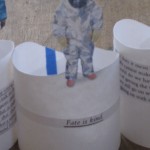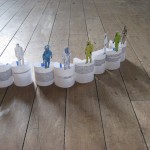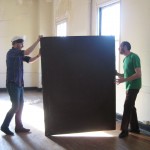What do booking a flight, tallying tax receipts, writing a letter of apology, trimming the strangely sharp tags from one’s new G-strings, and completing paperwork for a “Do Not Resuscitate” order have in common?
They are the dreaded and the deferred. They elude resolution, creeping from one day’s To Do list to the next. And they are all tasks people have put to rest at the Heinous Task Table.

The Heinous Task Table is an ongoing, participatory project I began as a way to explore – and enact – the supportive effect of working together on the things we avoid. It started as my own wish, whenever I tried to get through a stack of paperwork, to embark on this enterprise alongside another person.
I’d read all about productivity tactics: If I wanted to have more time to write, I just had to implement such systems as the Urgent/Important matrix. But did I have to navigate the cells of its quadrants, dispatching that which is both “Urgent and Important,” and not getting mired in the “Not Urgent & Not Important” all alone?
In place of this self-styled exile, I envisioned the limbic grounding of turning to these matters with friends. What if we could approach these tasks not from a posture of dread, but of curiosity? What if we could give these matters a place of importance and, more importantly, a place of inclusion?
Performed in forlorn sequestration, an otherwise simple chore becomes monolithic, but when they are brought to The Table, where participants can fill out reimbursement forms in the company of others attending to similarly loathsome matters, something mysterious happens. Here, in this kindred coterie, the cloak of overwhelm lifts, and burdens start to take on a more friendly proportion. And, perhaps most remarkably, to an unsuspecting viewer, the proceedings look like a party.
In 2007, as a summer student at Tassajara, I revisited the idea and held Heinous Task Nights in the back of the student dining room. Many people came by and asked us what we were doing and promptly left, saying they didn’t have time just then to join us. But the next morning, they’d report that just by knowing we were there, they’d suddenly been able to muster the prospect, for example, of getting their packing done.
A variation on this was those who said, “I can’t join you, but I’ll be thinking of you all here while I clean my bathroom.” Even further afield, I have intermittently held Heinous Task Nights on Tuesdays at 7 p.m. PT, and friends who live elsewhere join in, at 7 p.m. in their time zone. In this way, it’s not even happening at the same time, but there is, apparently, some kind of invisible field of morale that extends beyond the actual table and beyond the appointed time.

Chris Doyle attaching support to the underside of the table, Headlands Center for the Arts.
But, there have been and continue to be actual tables. This is the heart of the project. The tables all have had a quality of stability, or at least spaciousness, that offers a conceptual and literal holding environment. There was the leviathan of a walnut veneer conference table at The Headlands Center for the Arts Project Space, the picnic table in Tassajara’s student dining room, the long oak dining table in SFZC’s City Center dining room, and the two doors balanced on sawhorses in my apartment in New York.
In 2009, I conducted the project at Headlands for two weeks and created an area where anyone could come and work during public hours. In addition to the 16-foot table, there was also a smaller support table, dubbed Son of Heinous Task. It provided a place where people could read some encouraging literature and talk (as talk is kept to a minimum at the Table itself).
So, let’s consider what a heinous task is. There are the archetypal ones – taxes, bills, difficult letters – but it’s an entirely subjective category that includes just about anything. What’s more important is some sense of disproportion in the charge the task holds for the person.
Heinous tasks often carry a valence of either near obsolescence or great uncertainty. They might be so rooted in the past as to feel almost futile, as if the time has passed for it to matter, but there’s still some part that needs to be resolved, as in writing up case notes or sending back a pair of shoes. They are also speculative, for example applying for a grant, or an apartment, both of which also carry another defining attribute – asking for something.
Some tasks can be traded; others have to be done by the person, but maybe some part can be delegated. Many heinous tasks can be broken down into 20-30-minute increments. Some cannot be done at a table, but perhaps someone at the table might offer on-site help.
Often, of course, some larger process of letting go is implicated in the tenacious hold some tasks wield. Perhaps, they all have the tinge of death somewhere in their makeup, some of them, quite literally so, as with the woman who completed a Do Not Resuscitate form at the table. Or, if not literal death, then perhaps a sense of being displaced in time, of having to revisit a stale dilemma or trauma. The matter-of-fact gravity with which some people have sat down at the table has been striking. They bring stubborn tasks they’ve been carrying for years – a letter to their estranged sibling – and somehow just sitting at the table without even talking to anyone, they find the wherewithal to crest the resistance.

Heinous Task Table in the Headlands Center for the Arts dining room in 2009.
A friend brought her thorny task of making a “For Sale” sign for her car to one of the early Heinous Task sessions. As long as she didn’t make the sign, she didn’t have to sell the car. As long as she didn’t sell the car, she didn’t have to say goodbye to whatever it was the car still represented. Moving the marker across the paper so as to form the words For Sale, and then adding the pertinent details, took roughly 15 minutes to execute. A year to work up to it, and 15 minutes to make the sign. Done.
But who was she once the sign was made? This question, I feel, is at the heart of why we resist resolving these otherwise simple matters. And perhaps that’s why they’re easier to face simply by having someone else there to meet you on the “other side.”
When I posted a note on Facebook asking people to submit examples of their heinous tasks, the response was immediate and abundant. Taxes, of course, topped the list, along with writing thank you notes and condolence notes. Mending socks, washing a bathrobe, canceling engagements, bills, sorting mounds of paper… (see the list to the right for more).
As I read this catalog of the onerous, I was struck at how precious, and even luxurious, these ostensible hassles now seemed alongside the images from the tsunami and earthquakes in Japan. Also, I felt a tenderness for the specificity of what was difficult for each person.
And, as others reported, reading the list made me feel better about my own lists. Such a list says, “You are not solely ineffective.” Not cursed by a singular fate. The despair that you, alone, are the one stuck painting your molding while everyone else is having a salt massage is lifted. When there’s a shared intention to meet what is difficult or imperfect, it becomes more possible to tolerate the uncertainty of beginning the task.
This entry from The Book of Heinous Tasks, from my friend Shundo Haye, a regular at the informal Heinous Task Nights I’ve held on Tuesday nights intermittently over the last three years, captures the spirit of the project: “Tonight I sewed back the fraying seams of my favorite cycling gloves. It’s not pretty, but it might hold.”
Entries from The Book of Heinous Tasks: Being a List of the Dreaded and Deferred (contributors’ names withheld)
- An e-mail box with over 1000 e-mails I actually want to read.
- Cancelling things that people will not like me canceling.
- Cleaning the bathroom, especially the toilet base. What a drag.
- Condolence notes. I am afraid to write them, and so far, never have.
- Explaining.
- Filling out timesheets and creating a budget for domestic finances.
- Grading my students’ work. I put it off as long at humanly possible.
- Mailing letters that are written and sealed in addressed and stamped envelopes.
- Mending the holes my big toe makes in my socks.
- Opening mail I deem scary.
- Paying my hospital bill or telling them I don’t have the money to pay and applying for state aid.
- Researching scholarships.
- Revealing my vulnerability.
- Talking to my girlfriend.
- Washing my bathrobe.
- Writing treatment plans that no one reads.




